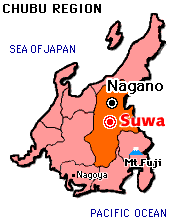


Suwa lies roughly in the middle of Nagano Prefecture. It has an area of 109 square kilometers (42 square miles) and a population of 52,000. The figures for all of Nagano Prefecture are 13,585 square kilometers (5,244 square miles) and 2.2 million people. It's a relatively small city noted for its manufacturing and sightseeing industries.
Silk production was the primary industry from the end of the nineteenth to the turn of the twentieth century. Today, many companies making high-precision equipment, like watches and cameras, are located there.The city lies on the eastern shore of Lake Suwa, Nagano's biggest lake (155 square kilometers, or 60 square miles). To its north lies the Kirigamine highlands, from where you can see all the way to Mt. Fuji and the Yatsugatake range. It has an inland climate with cold winters, although it doesn't snow very much. It is surrounded by natural beauty and houses many historically important buildings, making it popular with sightseers.
The vast Kirigamine highlands are designated as a quasi-national park and are located some 1,600 to 1,800 meters above sea level. There are many hills covered with pampas grass and alpine plants, and the marshland between the hills are a treasure house of rare marsh plants.
Suwa is also famous as the seat of the grand Suwa Shrine. It's not known exactly when the shrine was built, but it's certainly one of Japan's oldest, as mention of it can be found in the Kojiki, the oldest existing history of Japan, compiled early in the eighth century. Among the divinities enshrined there is the guardian deity of warfare, and many generals have worshipped at the shrine, including Takeda Shingen, the sixteenth-century warlord who based his military operations in Shinano (now Nagano).